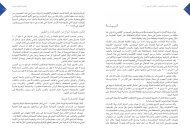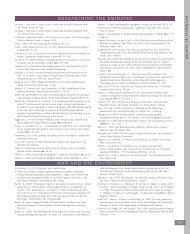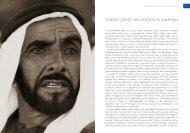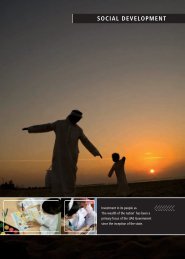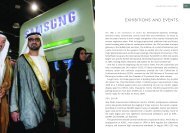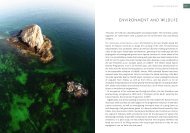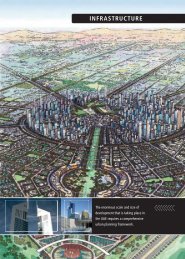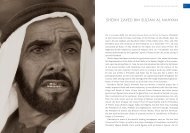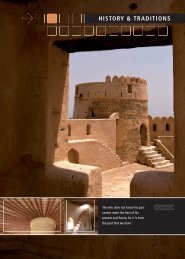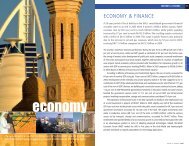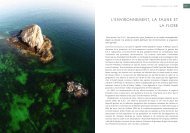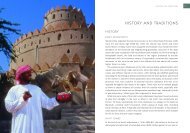84UNITED ARAB EMIRATES YEARBOOK 2006<strong>ECONOMIC</strong> <strong>DEVELOPMENT</strong>85Other sectors grew by varying amounts and more or less kept pace with theoverall increase in GDP. The real estate and business services sector was the newrising star in economic terms, growing by 14.1 per cent (from Dh23.3 billion in2003 to Dh26.5 billion in 2004). Not surprisingly, restaurants and hotels werein a close finish for top pegging in the growth stakes, increasing by 12.2 per cent(from Dh5.7 billion in 2003 to Dh6.4 billion in 2004). The financial corporationsector also put in impressive growth, increasing by 11.2 per cent (from Dh18.9billion in 2003 to Dh21.1 billion in 2004). Other rising sectors were electricity, gasand water, which grew by 11 per cent (from Dh5.8 billion in 2003 to Dh6.4 billionin 2004); the transport, storage and communications sector, by 10.1 per cent(from Dh21.1 billion in 2003 to Dh23.3 billion in 2004); the agriculture, livestockand fishery sector, by 9.6 per cent (from Dh8.9 billion in 2003 to Dh9.8 billion in2004), and of course the construction sector, which rose by 6.6 per cent, fromDh23.8 billion in 2003 to Dh25.4 billion in 2004, ranking it the sixth largest sector,after: 1. oil and gas, 2. manufacturing, 3. wholesale, retail and repair, 4. governmentservices and 5. real estate and business services.POPULATIONThe <strong>UAE</strong>’s population is rising at a rate of around 6.9 per cent, reaching 4,320,000in 2004 compared to 4,041,000 in 2003. With output growth increasing at aslightly faster pace than population, GDP per capita (at constant 2000 prices)increased in 2004 to Dh74,900 against Dh74,600 in 2003. By the end of 2005there were almost five million people living in the <strong>UAE</strong>. A strong economy,healthy social development and political stability have supported a steady risein population, making the <strong>UAE</strong> one of the fastest growing nations on earth.Additional factors supporting this growth include the influx of foreign workers,a sharp drop in infant mortality and a comparatively higher birth rate.The new census (see chapter on Social Development), which will be completedby the end of 2005, will provide the Government with more accurate figures onwhich to base future socio-economic planning.The <strong>UAE</strong>’s diversification programme has focused on a number of key areas,including aviation, port facilities, tourism, finance and telecommunications. Ithas also vigorously pursued various trade and investment agreements, bothwithin the Gulf region and with the rest of the world. Free-trade zones, whereforeign companies are allowed 100 per cent ownership, have also encouragedinward investment. The country’s strong transportation and communicationsinfrastructure has provided a basis for creating one of the world’s key trade andtrans-shipment hubs.Buoyancy in industries such as tourism, construction, aviation and servicescontinue to fuel the <strong>UAE</strong>’s economy and several reports issue at the end of thefirst half of 2005 predicted growth rates for the year. A July report predicted agrowth rate of 5.9 per cent for the year with inflation forecast to reach a highof 3 per cent and to stabilise thereafter. This inflation spiral was attributed to aweakness of the US dollar along with high liquidity and low interest rates in <strong>UAE</strong>’smarkets. The <strong>UAE</strong> Government, concerned about inflation, is particularly aware ofits impact on lower and middle income groups and salaried consumers. It is seenas a problem that needs to be quickly solved in order to maintain market stabilityand to avoid a lending crisis in which consumers borrow more to spend more.As trading and business conditions remained positive for the <strong>UAE</strong>, forecasts ofgrowth rates (and inflation) were revised upwards in the third quarter. A report byfinancial analysts EFG-Hermes, issued on 31 August 2005, predicted an expansionrate of 6.6 per cent in 2005, compared to 7.4 per cent in 2004, but suggestedthat this will slow to 3.6 per cent in 2006. Meanwhile, consumer price inflationwas expected to surpass 6 per cent in 2005, up from 4.6 per cent in 2004, asrobust domestic demand continued to fuel inflationary pressures, particularlyin the real estate sector.Another economic think-tank, Business Monitor International, issued a report inAugust 2005 stating that the <strong>UAE</strong>’s real GDP would grow 6.2 per cent in 2005,fuelled by record oil prices, but would slow to 4.3 per cent in 2006 and 3.9 per centin 2007 as oil prices ease.THE ECONOMY IN 2005A report by the World Bank (Economic Developments and Prospects for the MiddleEast and North Africa, 2005) highlighted the <strong>UAE</strong>’s ‘marked success’ in reducingits dependence on oil. The <strong>UAE</strong>’s non-oil exports were 52.3 per cent of the totalin the five years from 2000 to 2004 compared to 31.9 per cent in the 1970s and29.5 per cent in the 1980s. ‘Greater diversification enables an oil exporter tomore readily mitigate some of the negative effects of oil price decline’, thereport’s authors remind us. With recent oil price trends up rather than down,the economy has received a double boost, not just from extraordinary growthin the non-oil sector but also from higher than budgeted oil revenues.<strong>ECONOMIC</strong> OUTLOOK FOR 2006At the time of writing this edition of the <strong>UAE</strong> Yearbook (third quarter of 2005),official government reports provide provisional figures for 2004 and preliminaryestimates for 2005 but do not generally go beyond that. A number of economic‘think-tanks’, however, make forward predictions using information currentlyavailable. Whilst these may prove imprecise as a result of unforeseen circumstances,they are interesting in so far as they calculate how present performance andeconomic decisions are likely to impact on future growth. In mid-2005 theEconomist Intelligence Unit (EIU) issued a report that predicted a continuedstrong economic performance for 2005/06.
86UNITED ARAB EMIRATES YEARBOOK 2006The EIU predicted that the <strong>UAE</strong> economy would expand at an average annualrate of around 6.5 per cent in real terms during the 2005/06 period. This wasexpected to be driven by industrial growth, both in the oil sector where rises inproduction rates and prices of oil should play significant roles and, moreespecially, in the non-oil industrial sector where investment in manufacturingand heavier industrial projects (focused mainly on energy-intensive sectors suchas petrochemicals and metals) is likely to bring new capacity on-stream. At thesame time, competitiveness of <strong>UAE</strong> exports was being bolstered by the weaknessof the US dollar, further adding to growth-rate expectations. The EIU predictedthat domestic and foreign investment in new projects would remain strong, ‘whilecapital spending on real estate and infrastructure schemes (including new roadsand high-profile programmes such as the proposed Dubai Light Railway) will alsostay high’. The service sector was expected to attract significant investment, stronglyinfluenced by growth in tourism, which has already shown impressive potentialdespite regional uncertainties. Population increase should continue to underpinstrong domestic demand, as will the public and private sector salary increases.Overall performance in 2006 will continue to be linked to oil prices and the‘feel good’ factor will remain with spending expected to rise rapidly over theforecast period, fuelled in part by a general increase in salaries, together with risesin capital expenditure. Total spending is expected to grow by an annual average ofaround 10 per cent over the 2005/06 period.LOOKING FURTHER AHEADIn recent years, the <strong>UAE</strong> economy has, to a marked extent, become less dependenton oil and gas. Thus, according to Central Bank figures, the contribution of thenon-oil sector to GDP has risen from 54 per cent in 1990 to 71 per cent in 2004.While the continued upturn in oil prices has affected this ratio in recent years,the actual value of the non-oil sector continues to show impressive growth, and itis clear that the <strong>UAE</strong> has achieved considerable success in diversifying its sourcesof income.Diversification of the <strong>UAE</strong>’s economy will continue to play a vital role inmaintaining growth and stabilising the impact of oil production or price fluctuations.Continued efforts will be made to attract foreign direct investment, and indicationsare that these efforts will continue to bear fruit, becoming increasingly significantcontributors to economic growth. Dubai, in particular, will concentrate ondiversification in order to offset its dwindling oil income. Abu Dhabi’s focus onindustrial growth will also show positive results. This will not, of course, makeoil and gas unimportant, since the revenues they provide are, and will remain,the basic source for the financing of the national economy and for funding thenecessary infrastructure in other sectors.



